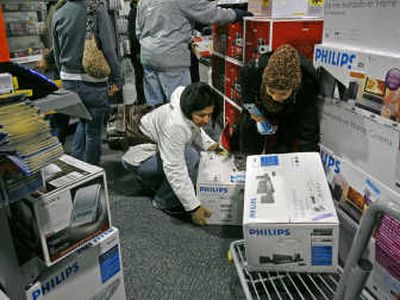Help for stocks? It’s wait, see

NEW YORK – Investors might not want to place too much faith in the notion that a strong start to holiday shopping might breathe new life into the stock market.
Black Friday may have gotten the season off to a good beginning: Many retailers reported, anecdotally, seeing more people than last year taking advantage of the day’s deep discounts.
One day does not a season make, however. Investors want to see the euphoria of the first shopping day of the season persist all the way until Dec. 25, and beyond, before they place a bet on how Christmas went.
“Consumer spending is always something we pay attention to, we want to see higher traffic on Black Friday,” said Ryan Larson, senior equity trader at Voyageur Asset Management. “But, results from just one day isn’t going to do it – the follow-through is more important from a trading standpoint.”
Stores are hoping for a surge of shoppers during the holiday shopping period after many consumers pulled back in recent months. Merchants hope longer hours and deeper discounts will help make sales goals even though consumers are facing a barrage of troubles such as a slumping housing market, tight credit and rising fuel prices.
So far, the gimmicks seem to be working. Shoppers shrugged off lead-tainted toy recalls and worries about the economy and jammed stores before dawn Friday to grab discounted TVs, toys and the Nintendo Wii.
But investors need to see more empirical evidence – such as same-store sales figures – before determining how retailers fared during the period, Larson said. Beyond any dramatic comments from the likes of Wal-Mart Stores Inc., the interpretation of sales data might shift as analysts get more information later next week.
That’s what happened last year. Investors, worried that consumer spending was in the midst of a major erosion, sent the Dow Jones industrial average down 1.2 percent on the first full session after Thanksgiving. But, experts later felt it wasn’t all that bad – and stocks that week were able to rebound.
The biggest post-Black Friday surge during the past 10 years was in 2003 – when the blue chip index soared 1.16 percent.